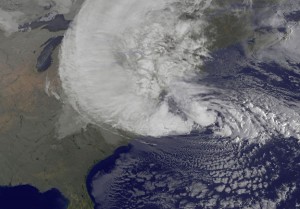
Sandy One Example of Consequences of Climate Change
As of this morning, New York City and other parts of the Northeast are dealing with catastrophic flooding. Lower Manhattan is without power, the subway is flooded, and most of the region from Virginia to New England has shut down. Hurricane Sandy, billed as a “Frankenstorm” – part hurricane, part Nor’easter – is historic. As a meteorologist at the National Weather Service put it in the days leading up to the storm, “What we’re seeing in some of our models is a storm at an intensity that we have not seen in this part of the country in the past century.”
There is substantial evidence that the storm took a sharply westward turn from the Atlantic Ocean and struck the east coast because of a high pressure system near Greenland. The Arctic reached a record low for ice cover this year, and the warming of the Arctic is altering the jet stream. As a result, a high pressure system lingered near Greenland, which blocked the hurricane from staying safely out at sea. The lesson is that climate change is increasing America’s vulnerability to extreme storms.
Addressing climate change certainly has costs. However, as The American Security Project has noted, there are costs of inaction – and the costs will only balloon the longer we wait. Last year, ASP published a report, “Pay Now Pay Later,” a state-by-state assessment of the costs of climate change. For New York, we noted that “the increased frequency of hurricanes, Nor’easters and other extreme events exposes New York’s coastal areas to hundreds of billions – if not trillions – of dollars in losses.” Climate change presents serious national security risks to the United States – to lives, infrastructure, the economy, and domestic security.
Let’s take a quick toll of the immediate costs of the storm. First and foremost, it has been confirmed that 33 people have died so far from the storm. We will have to see if that death toll rises, but for a storm of Sandy’s size – with a diameter of over 1,000 miles, Sandy is the largest storm to ever hit the region – such a remarkably low death toll is something we should be grateful for. Credit goes to emergency planners, first responders, and local, state and federal officials for preparing the region ahead of time and bracing for Sandy’s impact. The Washington Post Editorial Board wrote an article yesterday praising the regional response, which undoubtedly saved lives.
Another cost is to the damaged and destroyed buildings, houses, transportation networks and other infrastructure. New York alone has between $1.9 trillion and $2.5 trillion of insured property. New York City’s Subway, the largest in the country, was inundated with water, which may take several days to recover from. Sandy dealt a serious blow to roads, bridges, cars and houses up and down the east coast.
Not only do severe storms like Sandy threaten our economy through direct damages, but also to lost productivity. In the most densely populated region in the country, the “Frankenstorm” brought nearly 50 million people to a total standstill for days. Schools, businesses, entire cities and even the federal government were closed. Amtrak cancelled all service, air travel ground to a halt, and subway systems also shut down. It was eerie to see cities like New York and Washington DC resemble ghost towns.
The east coast will no doubt recover from this storm in the coming weeks. However, the destruction is another reminder of what we have in store if we fail to take action on climate change. What if a storm like Sandy, which has been called a “once-in-a-generation” storm, becomes a “once-in-ten-year” storm or “once-in-five-year” storm? Sure, taking aggressive action to reign in carbon emissions has costs. But, it will become increasingly difficult to ignore the costs of inaction.







[…] a previous blog post, I took a quick look at the immediate costs from Hurricane Sandy. Climate change made the […]
[…] Sandy was a horrific storm, inundating much of the East Coast, destroying homes, businesses, infrastructure, and leaving […]